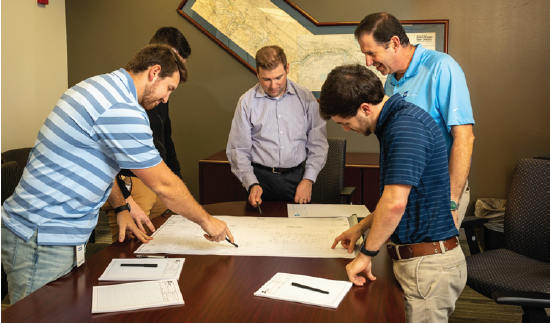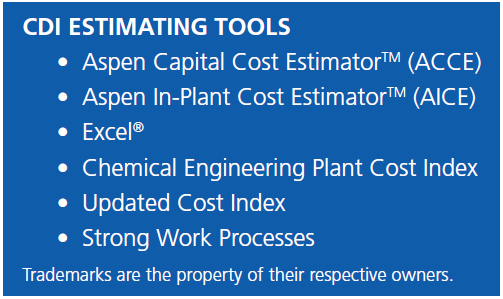
As a specific service, or as part of overall EPC or EPCM, CDI Engineering Solutions provides our clients with accurate and detailed estimates of the cost of a project, from conception to closeout. Our Estimating Department is led by Marty Belgard, a veteran project controls/estimating specialist with more than 40 years’ experience in the industry. With staff of seven estimators, CDI’s Estimating Team includes specialists in E&I, mechanical, and civil/steel. The estimators have an average of 26 years of industry experience. They complete 125 to 200 estimates annually, for projects ranging in size from $25,000 to $1.4 Billion.
Why do Owners Need a TIC Estimate?
- To Establish/Manage/Comply with Capital Budget
- To Select the Most Cost-Effective Alternative
- To Acquire Funding Authorization
- To Determine Return on Investment (ROI)
- To Make Sound Financial Decisions

Front-End Loading (FEL), also referred to as Front-End Engineering Development (FEED), has long been recognized as one of the most significant drivers of project success. Accurate cost estimates, in turn, are the most critical components of FEL. Engineering firms, the petrochemical industry, and independent resources use a wide range of nomenclature and terminology to describe the stages or levels of project development. FEL-1 through FEL-3, Level 1, Class I, Grade A-B-C, and so on. But no matter how you label the stages, two things are clear:
- In the earlier stages, your ability to affect costs by changes in design is relatively high, and the cost to make those changes is relatively low.
- The farther along you are in the project – or the more project details you have – the more accuracy and the less contingency in the estimate.
The Quality of an Estimates depends on the Quality of the Estimating Team. CDI’s estimating team has significant experience in providing comprehensive cost estimating services at each level of design development. Our team are experts at developing detailed construction cost estimates from the early conceptual programming levels – where there is minimal detail on plans – through schematic design, design development, and detailed design/construction documents. Here’s what some of our estimators have to say about working for CDI:


Gino Mustachio. “I’m an Estimator at CDI Engineering Solutions. We help companies develop a comprehensive understanding of necessary costs to bring capital projects from idea to realization. We provide estimates that allow companies to make confident decisions on design feasibility and appropriate funding. Providing cost estimates from $25,000 to $1.3B with accuracies of +/-10% to +/-50%, we bring the same amount of diligence, integrity, and experience no matter the request.”
Greg Laurent. “Our estimating process is forward-thinking and predictive in nature. There are many factors that influence the estimate, including current labor rates, material prices, and site constraints. We also consider market volatility, commodity prices, and the current availability of labor for a given project location. We use state-of-the-art software, Aspen Capital Cost Estimator (ACCE), to provide consistent and up-to-date material and labor units for every aspect of the estimate.”


Carmen Harris. “Developing cost estimates at each project “gate” allows our clients to evaluate and make the best scope decisions and the best financial decisions when it comes to planning yearly capital budgets and priority regarding project funding decisions. Working at CDI since 2006 has been the most rewarding experience in my professional career, in terms of knowledge growth and relationship building. Learning from our team of professionals, with a wealth of knowledge in the industry – and access to the best techniques and tools available – help us produce the most accurate TIC estimates for our clients.”
What are the Necessary Elements of an Accurate, Useful TIC Estimate?
- The Project Team (Owner and Engineer) and the Estimator must know the business objectives of the project. Increased Capacity? Improved Reliability? Regulatory Compliance? The estimators must know the objectives in order to ask the right questions, use the right perspective.
- The appropriate level of Project Data (Engineering, Design, Schedule, Equipment Selection, etc.) must be available to support the level of accuracy of the
 Estimate. The saying “garbage in, garbage out” is actually true. The TIC CDI ESTIMATING TOOLS estimate is only as good as the data used to develop it.
Estimate. The saying “garbage in, garbage out” is actually true. The TIC CDI ESTIMATING TOOLS estimate is only as good as the data used to develop it. - The Best Available Estimating Tools must be used, and must be updated to reflect current conditions (labor rates, productivity, material pricing, etc.) CDI has state-of-the-art estimating tools.
- The Estimating Process must be rigorous and consistently applied. Trademarks are the property of their respective owners. Consistency is important, particularly when team estimating is required for large projects. CDI performs a Peer Review and Management Review of TICs before publication to ensure that CDI estimating processes are followed.
- The estimate presentation must be easy to understand. CDI TIC estimate presentation is easy to understand and facilitates easy client review / validation so that the Estimate obtains joint ownership.
- Client validation (“buy-in”) of the estimate is absolutely essential. If the Client does not provide input and have confidence in the estimate, it will be of little or no value to them.
We welcome the opportunity to demonstrate our estimating skills and processes in more detail. Please call us to schedule a meeting or “lunch & learn” at your location, virtually, or at one of our CDI offices.

